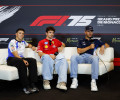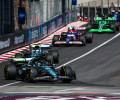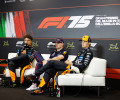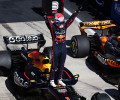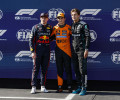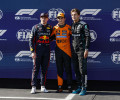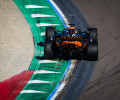2013 Malaysian Grand Prix - Friday Press Conference

TEAM REPRESENTATIVES – Bob BELL (Mercedes), Cyril ABITEBOUL (Caterham), Robert FEARNLEY (Force India), Sam MICHAEL (McLaren), James ALLISON (Lotus), Pat FRY (Ferrari)
PRESS CONFERENCE
James, can we start with you? A great win for you and the team to start the year off in cold conditions in Melbourne and from what we saw this afternoon can we conclude that you’re pretty quick in the heat as well?
James ALLISON: The weekend will tell but it’s been a good day so far and the car seems quite happy here.
Is there any circuit that you fear from here?
JA: All of them! You just take them one at a time. It would be good to come away from here, if we can, competitive. So I think doing well in cold and doing well in hot would be good.
Will you able to maintain that development throughout the 2013 season against your main rivals?
JA: I think our team has got a reasonable history of keeping up with, and sometimes exceeding the general development race that happens during the season.
Can you say anything about the way Kimi Raikkonen drove in Melbourne. There seems to be a surge of confidence really. He’s gone up a level has he, since last year?
JA: He’s certainly very, very relaxed and confident this year. He drove the race incredibly patiently. I think he knew he had a good car under him. He knew he didn’t have to scamper up behind the group in front and he looked after the tyres, only going quickly when he needed to. It was just a very mature and smooth, fast race.
Bob Bell, last year the Mercedes was very good in cold conditions, perhaps less good at places like this. Have you addressed that with this car?
Bob BELL: Yes, I think we very much hope we have. We put a lot of effort in over the winter to really understand what the issues with last year’s car were. We had a pretty reasonable winter test in cold conditions. Of course Melbourne, as you said, was cold as well. We’ll see when we come away from here whether we’ve actually got on top of those issues. I think we’re pretty upbeat, pretty confident we’ve achieved that.
What differences have you noticed in the way you’re operating as a team with the arrival of Lewis Hamilton?
BB: Lewis, no question, is a new dynamic for us and that always happens with the introduction of a new driver, particularly one as competitive as Lewis is, so he’s a real motivational force in the team and indeed for his own team-mate. I think he’s lifted all of our game. He’s driving us; he’s clear about what he wants, what direction he wants to go in, and that is sympathetic to where we were going anyway, so I think it’s going very well.
What effect do you see he’s had on his team-mate Nico Rosberg?
BB: Team-mates naturally always want to outdo each other, so if you bring a new one in, if that raises his game then I think his team-mate will try and follow suit. It’s perfectly natural healthy competition.
Pat Fry from Ferrari – second place finish in Australia, ahead of Red Bull. You’re leading the Constructors’ Championship going into this race. What was the feeling, the mood like in the post-race debrief?
Pat FRY: I think people were pleased with the race pace of the car. It was quite obvious that Kimi was going to be two-stopping. I think you could see him two seconds back from the group, as James mentioned. I don’t think we could have followed suit and competed on a two-stop which is why we went for the aggressive three-stop, which got us through the traffic. All in all, it’s one those… with that and the 60km/h pit lane limit, it’s always that balance between two-stop and three-stop. We weren’t brave enough to make the two-stop work. Kimi was, so good luck to them, or well done to them. We just need to keep on working on the pace of it. It’s nice being second but you always want to win don’t you.
What are your thoughts about the pace of Lotus, the way they’ve started the season?
PF: It is very good. I don’t think we would have been brave enough to have attempted a two-stop there, so yeah, I think they’ve done well.
Can you talk a little bit about the renaissance of Felipe Massa? Obviously he was strong in the second half of last year, he out-qualified Alonso in Melbourne and raced ahead of him for two stints. What is it that’s changed in him do you think?
PF: It’s hard to say really. He’s got a good attitude. He’s driving very well. Very sensible not overdriving the car. If you look at last year the first half was a bit of a struggle, the second half was a lot better and he’s continued that form into this year, which is obviously good for us as a team in the Constructors’ [Championship].
We’ll come to Bob Fearnley from Force India. Force India obviously led the last race of 2012 in Brazil and you led twice in Melbourne last weekend en route to seventh with Adrian. What’s the outlook, do you think, for the year ahead?
Bob FEARNLEY: I think the Brazil race was on merit to a degree what we did in Melbourne obviously was tyre choice. It was very nice to be there but it was the result of strategy more than anything else. Overall, I think the performance of the car and team is quite good at the start of the season.
Q: And what was the problem for Adrian Sutil? We saw him in his shorts with half an hour to go.
BF: We had an oil seal problem. We just needed to stop it to make sure there was no damage to the engines.
Q: Can you talk a little about Sutil, his return from over a year out of a Formula One cockpit, very little testing. Were you surprised by his performance?
BF: I wasn’t surprised after his test in Barcelona. I think in Barcelona, when Adrian came in, if anybody could have put together a perfect assessment of a driver coming in for a test it was that occasion. I think Adrian did a great job and didn’t surprise me at all in Melbourne.
Q: Cyril, Caterham one of I guess three teams that were perhaps a little disappointed with performance in Melbourne – perhaps along with Williams and McLaren – what’s going on behind the scenes at Leafield that gives you confidence going forward?
Cyril ABITEBOUL: Clearly, I think that we have chosen to go for a strategy that is a little bit different from other teams, in the sense that we do not operate our new car for now. We have strategies that will make the car evolve according to different packages, the first of which will come in Bahrain. So we are running right now on hybrid car, so we are pretty much where we expected it to be. It doesn’t mean it is where we wanted it to be. Having said that, we have been analysing clearly the difference, the gap between Marussia and our car. First we want to diminish a little bit the fight between Marussia and ourselves. We are just competitors and we would like to make our way up through the grid, not backwards but up towards the front. Clearly we see most of the developments that we did over the last year, the last 12 months, we think they made two-thirds of the difference over the last 12 months and only one-third over the winter. And of that one-third only half is coming from KERS. So I think that we have a real chance to be optimistic. Some good stuff is happening in the wind tunnel. Obviously we want to make sure this is translating into reality in Bahrain.
Q: Obviously it’s a home race for your Malaysian shareholders. How’s it looking for this weekend?
CA: It’s looking pretty much similar to the last weekend in the sense that it’s going to be on the edge with Marussia. I think the utilisation of tyres and driver familiarisation, driver mistakes also can make a difference so this is what we are getting ready for. We are going to have our shareholders present, so we want to make sure we have a good show at that moment.
Q: Sam, the team and drivers were very open in Melbourne about the problems that you were suffering with the car. Can I ask you what went well that weekend?
Sam MICHAEL: I think we got close to extracting most out of the car. First of all it goes without saying that we’re not… there’s no-one in McLaren who’s satisfied with where our performance is. So we’ve spent a lot of time in the last few weeks – before Melbourne as well because we had all the signs there from winter testing – going through data and analysing exactly what we need to do to improve the car. We’re about winning races, as we proved at the end of last year. We made some quite substantial changes to the car with a view that over the course of the season they would pay us back in terms of wins. I’d say that we… all of the people inside the group at the moment are focussed on understanding the 28 and turning it into a winner as soon as possible.
Q: Presumably you’ve considered – you won the last two races of last year – you’ve considered bringing last year’s car? Have you now ruled that out as a plan?
SM: All of our focus is on the current car. That involves understanding it, doing tests, we’ve done a lot of testing today actually on the circuit, we’ve done a lot of work in the factory in the last four or five days since Melbourne, making some encouraging progress in those areas, so right now all of our efforts are concentrated on the current car.
Q: What does your experience tell you about how long it will be before you’re challenging the two gentlemen [Fry, Allison] to the right?
SM: As soon as possible – but it’s very hard to make predictions because when you’re trying to unlock two or three different areas on the car, my experience tells me it’s very unpredictable to know when that’s going to happen. What I will say is the past history of McLaren as a group to recover from situations like this is extremely strong and consistent. They’ve done it before and I don’t see any reason why the engineers won’t do it again this time – especially based on the activity that I’ve seen and we’ve all been involved in over the last couple of weeks. I think it won’t take long for us to be back up there – that’s the target.
Q: It looked like Jenson Button in particular was a bit closer to the pace when the conditions got more changeable after the rain. Are you hoping for more of those conditions over the weekend?
SM: Hopefully. That was a trend that we saw in Melbourne as well – that we were extremely competitive on intermediate conditions. Not so much on full wets, and the slicks… we know where we are. We’ll see what happens. Normally here it’s full wet or nothing. It’s one of those one zone-type tracks.
QUESTIONS FROM THE FLOOR
Q: (Dieter Rencken – The Citizen) To the two engineers plus anyone else if you’d like to contribute: last week we had qualifying delayed and then run on Sunday. We’ve had races red-flagged here and postponed - it’s been happening more and more recently. Is there any way the sport can put together regulations where we can minimise the number of either red flags or postponements to give the fans what they really come here to see and pay for?
PF: I think that with the conditions you sometimes get here, there’s so much rain, it would just be impossible to run so I think we can try and make the cars safer to run and I think we have but purely down to the... is there a tyre good enough for the conditions... there was a downpour in 2009, wasn’t it... you’re never going to make something that can survive that kind of situation.
Q: (Dieter Rencken – The Citizen) Sorry, I’m talking generally, not just about here, because we’ve had it in Canada and all over the place. So I’m saying should we not be looking at a committee to investigate some way of overcoming this, not necessarily just here in Malaysia?
PF: I just think that for me, personally, I just think it’s a very difficult thing to overcome. With that much water, it’s not safe to run. Whether the FIA want to get a committee together to try and understand and see if it is possible to run in that, that’s entirely up to them.
JA: I haven’t got a lot to add. You know, you’ve seen it. The spray becomes impenetrable very quickly and the cars start to aquaplane. You could do something about the aquaplaning to an extent, with a different set of tyres, but the spray would still be an issue and there would still come a point where the aquaplaning would dominate, especially at places like this so I don’t think technically there is much of a solution. We just have to wait for when there are conditions that a car can run.
BF: Not unless anybody’s got a quick connection to the man upstairs, no.
BB: No, I don’t think I can add anything to that. I think the teams are genuinely busy enough trying to design the car to meet the existing regulations. I’m sure the FIA have it within their power to investigate these things and see whether something could be done but as far as the teams are concerned, we’ve just got to get on and do the best job we can within the regulations as they currently stand.
Q: (Kate Walker – Girl Racer) Mr Fernley, over the last few races – last season, we saw it last week as well – you guys seem to have made a deliberate decision on the pit wall to split your strategies and do almost opposite things with your two drivers. Is this a lack of confidence in your strategic decisions, or is it something more deliberate?
BF: I don’t think it’s a lack of confidence. I think I would have thought that Melbourne was obvious, that you’ve got one driver that’s qualified on a supersoft and then you’d be the first of the contenders running on the medium. I didn’t think there was anything risky in that at all.
Q: (Kate Walker – Girl Racer) It just seems that with that kind of approach, it’s not just in Melbourne, we did see it in 2012 as well, that it will give one driver the opportunity to finish really well and the other less so. Not that you’re favouring one over the other, it was an even split. I was just wondering what the thinking behind that approach was?
BF: Well, I think in 2012 you’ve got a slightly different process there because obviously we were defending – not defending, actually we were attacking and trying to get our position back from Sauber, so what you’re trying to do is maximising the opportunities for optimum points and that would be the reason for the main split of the strategies. But where possible, you’re always going to go for an optimum strategy for both drivers and we would do that. I think in Melbourne that was an optimum strategy for both drivers.
Q: Speaking of two different drivers, James, what’s the situation with Romain Grosjean? He’s not been quite on Kimi’s pace in the first Grand Prix and obviously again today he seems to be a bit behind; what’s your analysis?
JA: Romain showed us over and over again last year that he is a driver with a lot of pace. That’s the one really valuable commodity that a race driver has and he’s got that. He’s not had an easy weekend either here or there, because we haven’t been able to provide two cars in exactly the same configuration on either occasions so in Melbourne on Friday he was running a step behind Kimi in terms of his aero package, and then he had the upgrade for Saturday morning but then Saturday was disturbed by the weather as we all know. Here, once again, we only have one set of kit and we’ve chosen to run that with Kimi and Romain is disadvantaged for that. It’s a feature of not having in-season testing that you try to upgrade the cars as fast as you can and generally speaking, that means that you’re always going to have one set of kit ahead of the second set and that almost inevitably means that one driver gets to try it before there is a second one available. We will always try to get two sets available but not always possible. So he’s had a difficult set of circumstances and he’s also up against a teammate who is really firing on all cylinders so those are the two things.
Q: (Alex Popov – RTR) Cyril, can you clarify the story of a possible merger with Marussia?
CA: Yeah. I think we provided a comment – both Marussia and ourselves – regarding the fact that there have been some discussions over the Christmas period but clearly I think we all know that business, we all know Formula One, we know that it’s quite a fluid and versatile environment. To be honest, I’m not that old and since I’ve been in F1 I think I’ve maybe heard ten times about mergers, including four big names, so there is nothing very big in that. We looked at that, we looked at whether it was making any sense, it didn’t make any sense, it didn’t happen. End of story.
Q: (Luigi Perna - La Gazzetta dello Sport) Pat, are you confident you can have the same pace as Lotus or even better in this race compared to Melbourne?
PF: I think our race pace should be OK here, similar to Melbourne. In terms of tyre degradation I’m not sure yet. We need to go and look at the numbers. Obviously today’s running was a little bit mixed up. When everyone was doing their long runs this afternoon, there was rain in turns six and seven, so we need to see. Hopefully we will be able to get the degradation under control as well.
Q: Is it likely to be another race where doing one less stop than your rivals is one of the keys to success, do you think?
PF: I’m not sure how close we are to a three to four changeover or a two to three changeover. We need to have a look through the data and see really. I’d like to see James try and two stop here on Sunday.
Q: James, do you fancy it?
JA: Generally speaking this track is one stop more than Melbourne, so I think that might be a bit brave.
Ends

 Facebook
Facebook Twitter
Twitter